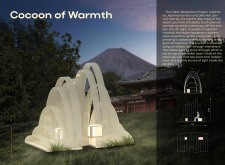5 key facts about this project
The Cabin Medication Project, titled "Cocoon of Warmth," is placed within an urban environment, designed to offer a peaceful escape for those living in the city. Drawing inspiration from Japanese lanterns and Peruvian groundcherries, the design incorporates a dual purpose. During the day, the cabin provides warmth and comfort through specially designed seats. At night, it becomes a lantern, casting light and enhancing the surrounding area. The design focuses on creating a connection between the interior space and the outside world, allowing users to feel a sense of calm in a bustling environment.
Structure and Materials
The pavilion features a flexible, see-through membrane that interacts with light, creating a welcoming atmosphere. This membrane sits atop a wooden base, providing stability while reinforcing a link to the natural setting. The choice of materials is deliberate, ensuring the structure is both durable and light in appearance.
User Experience
Inside, the cabin contains two heated seats that encourage relaxation. These seats warm up the space and serve as sources of light at night. This thoughtful integration supports user comfort and emotional well-being, making the cabin a place for quiet reflection amidst city noise.
Functionality at Night
As the sun sets, the building's ability to emit light changes its role. It shifts from a quiet retreat to a bright presence in the dark. The light it casts highlights the structure and its surroundings, creating a visual appeal that engages users. This change marks a clear transition, rich with the patterns of light and shadow that enhance the experience of all who are nearby.
The careful design fosters a strong connection between the architecture and its environment. It addresses both practical needs and emotional comfort, creating a space that lights up the urban landscape while offering refuge to its users.



















































